At the Sahti Academy
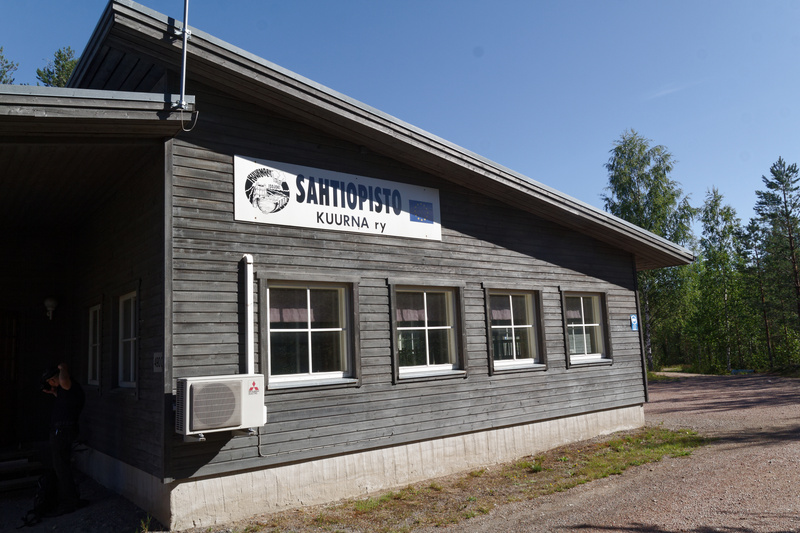
The Sahti Academy building in Isojoki |
One of the most notable stands at the sahti championship belonged to the so-called Sahti Academy (Sahtiopisto), an association of sahti brewers in the small town of Isojoki, who have joined forces to promote their sahti brewing heritage. The day after the championship we paid them a visit. (This was part of the Finnish sahti expedition of 2018.)
We were met by Tapio Alatalo, one of the leaders of the academy. And the academy turns out to be a quite substantial organization. They first formed an association of brewers, back in 1997, with 20-30 members. They decided they needed something a bit bigger, so they applied for EU funding, got it, and started building the academy building. Which is quite extensive with a course room (doubles as tasting room), a brewery with two brewkits, a malting facility, and what they call "the control room", where members relax while waiting for their malt to dry.
The academy has grown over the years, so they now have about 100 members. Tapio was proud to tell us that 10 of the national champions over the years have come from the academy, showing how much prestige was attached to the national championship. And given that the championship had only been arranged about 25 times that's quite a record for one small municipality.
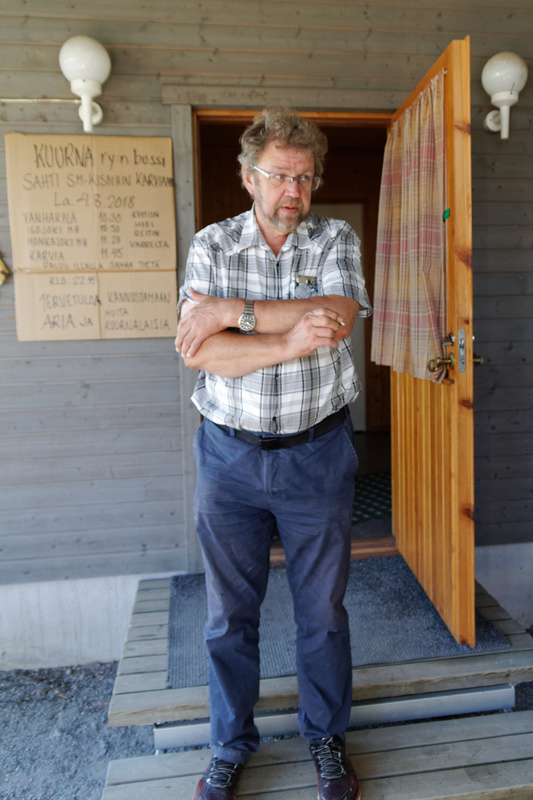
Tapio receiving us |
Tapio started us off with a small sahti tasting where we got to try three different sahtis. Two by Tapio, and a third by another academy member. The three were quite different, and the difference was mainly the amount of rye malt. The first beer had no rye, the second 30%, and the third was "mostly rye", both malted and unmalted. All brewed from their own malt.
All three were step-mashed raw ales, as sahti should be. The third had that viscosity so characteristic of many sahtis, and in this case it was so viscous that the beer was no longer fully liquid. So it may well be that the rye used in many sahtis is what give them that viscosity.
We started peppering Tapio with technical questions, of course, through Mika as translator. Mika told us the original gravity of Tapio's beers was 25 Plato (1.106 SG). "He actually measures the gravity," I asked, surprised to meet a farmhouse brewer who does. Mika conferred briefly with Tapio, then said "he hasn't measured these two beers specifically, but that's what his OG usually is. He says he can tell by taste." Which is just so deeply characteristic of farmhouse brewers: even when they have the equipment and the know-how they usually don't bother measuring gravity, because they get by just fine without it.
I had brought my refractometer, as I always do, and Mika said he'd brought a hydrometer. It wasn't planned, but this was perfect. Mika could measure the beer and find the final gravity. My refractometer would not give us the correct final gravity, because the reading would be distorted by the alcohol. Usually, people correct for that distortion by using the original gravity, but we didn't have that. However, we realized that since we have the FG and the distorted hydrometer FG that actually gave us all we needed to estimate the OG by just using the same equation to make a conversion table.
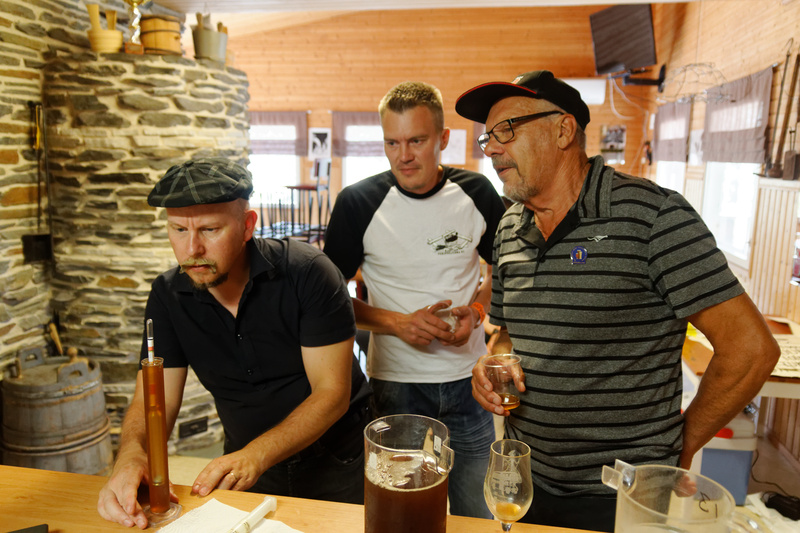
Mika measuring gravity while Kari Harju and son look on |
So of course we did just that.
The FG of Tapio's two beers were 1.029 and 1.026, and when I did the calculations I found the OGs were estimated as 1.107 and 1.101. Yeah, Tapio probably could tell by taste, it turned out. These two sahtis were then 11.6% and 10.9%, which, as I was about to learn throughout the course of the week, is completely normal for sahti. The third beer was 10.5%. The winner of the sahti championship the day before, Kari Harju, dropped by, and his sahti turned out to be 12.5%.
From the tasting room we went to the brewery, a quite large room lined floor to ceiling with bathroom tiles. It contained two brewkits made from repurposed dairy equipment. For us enthusiasts of traditional farmhouse brewing that was a bit sad, since these were clearly modern innovations. But for the members of the academy it's no doubt very practical. And the beer shouldn't be very different from what people made with the more traditional equipment.
I asked if anyone was brewing modern beers (like IPA or porter) in the academy, but was told the only ones were local pub owners who brew modern beer for their pubs. Since there's no boiler they have to boil the wort in the mash heater. Tapio didn't seem to know about any modern home brewers in the area.
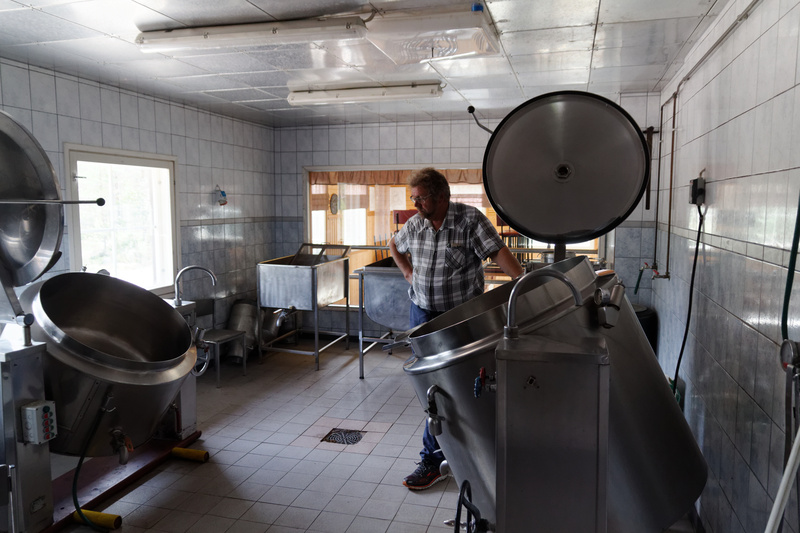
In the brewery |
Next up was the malting facility. Some of the members are farmers, and use their own grain, the others buy local grain. It goes into a metal tank they use for soaking the grain, with a device that adds oxygen. From there it goes onto a wire mesh frame for the germination, and the same frame is used for drying.
They have a heater and fan blowing hot air in underneath the frame so it rises through the malt, drying it. There's also a system for injecting smoke, and some of the members used that to smoke their malt. Tapio said they mostly used alder and birch for the smoking. Some members have experimented with beech as well, but that doesn't actually grow in the area. I had to ask what people used traditionally, and Tapio said alder was the traditional wood.

Malt drying frame |
Tapio brought out a sack of rye malt and opened it to show us their malt. It was very pale, and tiny pieces of the shoots and rootlets were still on it. What surprised me more was to find a little black piece looking like a long, twisted rye grain. It was ergot, a toxic fungus that grows on cereal grains. Tapio confirmed it was ergot, but he said the malt contains so little that it's safe.
From the FDA guidelines he seems to be right, which is a good thing, because consuming ergot can cause some really nasty symptoms, including hallucinations, gangrene, and ultimately death. Historically ergot poisoning was a considerable problem as late as the 19th century, but today it's successfully reduced to levels where it's no longer a problem.
I tried asking Tapio a bit about the old days, and he said he learned to brew from his father. Back then they used an iron pot to heat the mash, and wooden vessels for the rest of the brewing process. The vessels were cleaned with juniper infusion, and juniper and straw were used for filtering. In the old days they dried the malt in the sauna, and the beer used to be lightly smoky. Their descriptions of the old days sounded very much like traditional brewing elsewhere.
And then, regretfully, we had to leave.
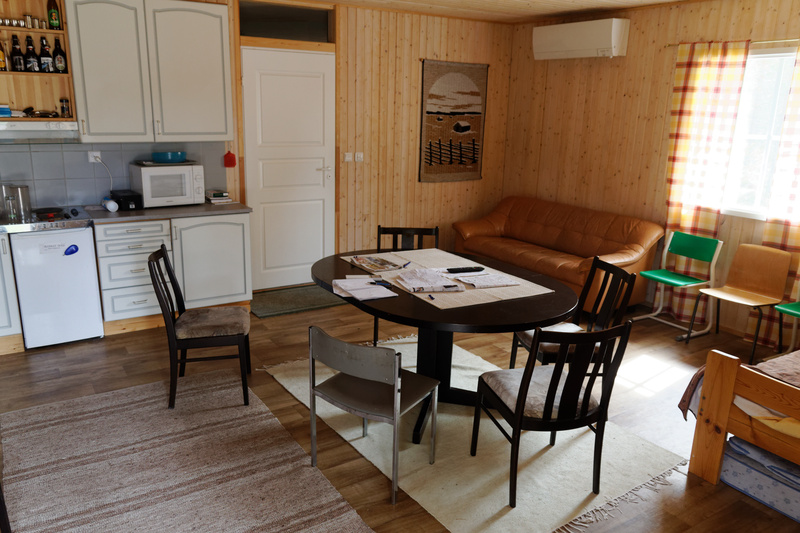
"Control room" |
Similar posts
The great Finnish sahti expedition
As farmhouse ale styles go sahti is quite well documented in print, but if you really want to understand a kind of beer there is no other way than to go there
Read | 2020-09-20 10:56
The sahti championship in Karvia
A large, empty sports field, with some cars parked round the edge
Read | 2020-09-27 10:21
Brewing with Olavi the champion
We drove along dirt roads through seemingly empty forest for half an hour, the dust curling lazily behind us
Read | 2021-05-22 13:26
Comments
Travis Y - 2021-01-12 06:08:54
Hello, I recently received your book a Christmas present from my brother. His reasoning because I am an avid beer drinker and have been dabbling in making home brew recently, and also I am an graduating historian. My comment is do you have more to say of the (Keplin, the ale/beer brewed from the mash being baked in the oven your blog post, seem to follow your notes from the book. Recently, I unintentionally made a faux sahti with oatmeal and herbs; wormwood, mug wort, and lemongrass, and it resembled some of the pictures and tasting notes from your book. But I digress, so your pictures and notes about the oven baked beer/ale seem to be about temperature and how the levels of water boil, and carmelization, being that i also have a culinary degree, could you make the baked wort by using a shallower pan and spread the mash out more or could you possibly stir the mash while it is in the oven. Also, something I was noticing from the book was the fact some of the brewers were using kviek, ale/beer, and bread yeast, was there really any loss in quality if you used one or the other, because like in the aforementioned ale, I had used two packets of bread yeast, and I though I had failed, and this brewing was before I had received your book. Then as I was reading: *which I thoroughly enjoyed because it was set like a text-book,* it seemed like I had made this style of ale without realizing it.
Thank You, An Amateur in the States.
Barm - 2021-01-20 22:57:50
Very interesting post. I was intrigued by the all-rye sahti. Is this common? Everything else you and Mika have posted suggest rye content of under 10%.
Did the oven-baked rye beers you had in Russia (which are the only other all-rye beers I know of) have the same viscous nature? If not then there is something in the long mashing regime that is destroying the rye pentosans that make it goopy.
Lars Marius Garshol - 2021-01-21 07:32:02
@Barm: No, all-rye sahti is not at all common today. I don't know if there were people who did it historically in Finland. The answer will be in the national museum archives, but it's in hand-written Finnish, so ...
That's the weird thing: the Russian beers were not viscous at all. But they had a completely different mash regime, and that may be the reason.
Ruwindu Gunatilake - 2021-03-04 08:56:56
Hello Lars, I was a pretty avid reader of your blog for a long time (even before I could drink beer!). I wanted to have a crack at brewing these very ancient and deliciously strong brews so I had a crack at brewing Sahti. My process was a bit janky and Australia isn't necessary a very inviting climate for farmhouse brewing but I did manage and it was one hell of an interesting beer (I am now of age to drink of coarse!). I'm a bit of a fanatic when it comes to obscure beer styles and I wanted to try and brew an oat based farmhouse ale. I believe you mentioned that in western Norway oat based farmhouse ales was more common a while ago. I wonder whether any modern farmhouse brewers use oats at least partially in their mash. Do you have any good information on this?